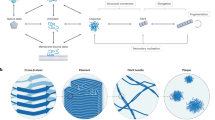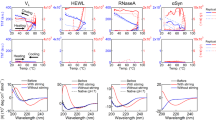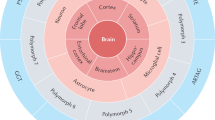Abstract
The conversion of proteins from their soluble states into well-organized fibrillar aggregates is associated with a wide range of pathological conditions, including neurodegenerative diseases and systemic amyloidoses. In this review, we discuss the mechanism of aggregation of globular proteins under conditions in which they are initially folded. Although a conformational change of the native state is generally necessary to initiate aggregation, we show that a transition across the major energy barrier for unfolding is not essential and that aggregation may well be initiated from locally unfolded states that become accessible, for example, via thermal fluctuations occurring under physiological conditions. We review recent evidence on this topic and discuss its significance for understanding the onset and potential inhibition of protein aggregation in the context of diseases.
This is a preview of subscription content, access via your institution
Access options
Subscribe to this journal
Receive 12 print issues and online access
$259.00 per year
only $21.58 per issue
Buy this article
- Purchase on Springer Link
- Instant access to full article PDF
Prices may be subject to local taxes which are calculated during checkout






Similar content being viewed by others
References
Selkoe, D.J. Folding proteins in fatal ways. Nature 426, 900–904 (2003).
Westermark, P. et al. Amyloid: toward terminology clarification. Report from the Nomenclature Committee of the International Society of Amyloidosis. Amyloid 12, 1–4 (2005).
Chiti, F. & Dobson, C.M. Protein misfolding, functional amyloid, and human disease. Annu. Rev. Biochem. 75, 333–366 (2006).
Bemporad, F. et al. Sequence and structural determinants of amyloid fibril formation. Acc. Chem. Res. 39, 620–627 (2006).
Guijarro, J.I., Sunde, M., Jones, J.A., Campbell, I.D. & Dobson, C.M. Amyloid fibril formation by an SH3 domain. Proc. Natl. Acad. Sci. USA 95, 4224–4228 (1998).
McParland, V.J. et al. Partially unfolded states of beta(2)-microglobulin and amyloid formation in vitro. Biochemistry 39, 8735–8746 (2000).
Litvinovich, S.V. et al. Formation of amyloid-like fibrils by self-association of a partially unfolded fibronectin type III module. J. Mol. Biol. 280, 245–258 (1998).
Fändrich, M., Fletcher, M.A. & Dobson, C.M. Amyloid fibrils from muscle myoglobin. Nature 410, 165–166 (2001).
Ferrão-Gonzales, A.D., Souto, S.O., Silva, J.L. & Foguel, D. The preaggregated state of an amyloidogenic protein: hydrostatic pressure converts native transthyretin into the amyloidogenic state. Proc. Natl. Acad. Sci. USA 97, 6445–6450 (2000).
De Felice, F.G. et al. Formation of amyloid aggregates from human lysozyme and its disease-associated variants using hydrostatic pressure. FASEB J. 18, 1099–1101 (2004).
Chiti, F. et al. Designing conditions for in vitro formation of amyloid protofilaments and fibrils. Proc. Natl. Acad. Sci. USA 96, 3590–3594 (1999).
Schmittschmitt, J.P. & Scholtz, J.M. The role of protein stability, solubility, and net charge in amyloid fibril formation. Protein Sci. 12, 2374–2378 (2003).
Booth, D.R. et al. Instability, unfolding and aggregation of human lysozyme variants underlying amyloid fibrillogenesis. Nature 385, 787–793 (1997).
Raffen, R. et al. Physicochemical consequences of amino acid variations that contribute to fibril formation by immunoglobulin light chains. Protein Sci. 8, 509–517 (1999).
Stathopulos, P.B. et al. Cu/Zn superoxide dismutase mutants associated with amyotrophic lateral sclerosis show enhanced formation of aggregates in vitro. Proc. Natl. Acad. Sci. USA 100, 7021–7026 (2003).
Sekijima, Y. et al. The biological and chemical basis for tissue-selective amyloid disease. Cell 121, 73–85 (2005).
Kelly, J.W. Alternative conformations of amyloidogenic proteins govern their behavior. Curr. Opin. Struct. Biol. 6, 11–17 (1996).
Dobson, C.M. Protein misfolding, evolution and disease. Trends Biochem. Sci. 24, 329–332 (1999).
Frauenfelder, H., Sligar, S.G. & Wolynes, P.G. The energy landscapes and motions of proteins. Science 254, 1598–1603 (1991).
Karplus, M. & McCammon, J.A. Molecular dynamics simulations of biomolecules. Nat. Struct. Biol. 9, 646–652 (2002).
Roder, H., Elove, G.A. & Shastry, M.C.R. in Mechanisms of Protein Folding 2nd edn. (ed. Pain, R.) 70–72 (Oxford University Press, Oxford, 2000).
Pepys, M.B. et al. Human lysozyme gene mutations cause hereditary systemic amyloidosis. Nature 362, 553–557 (1993).
Valleix, S. Hereditary renal amyloidosis caused by a new variant lysozyme W64R in a French family. Kidney Int. 61, 907–912 (2002).
Yazaki, M., Farrell, S.A. & Benson, M.D. A novel lysozyme mutation Phe57Ile associated with hereditary renal amyloidosis. Kidney Int. 63, 1652–1657 (2003).
Röcken, C. et al. ALys amyloidosis caused by compound heterozygosity in exon 2 (Thr70Asn) and exon 4 (Trp112Arg) of the lysozyme gene. Hum. Mutat. 27, 119–120 (2006).
Canet, D. et al. Local cooperativity in the unfolding of an amyloidogenic variant of human lysozyme. Nat. Struct. Biol. 9, 308–315 (2002).
Dumoulin, M. et al. Reduced global cooperativity is a common feature underlying the amyloidogenicity of pathogenic lysozyme mutations. J. Mol. Biol. 346, 773–788 (2005).
Canet, D. et al. Mechanistic studies of the folding of human lysozyme and the origin of amyloidogenic behavior in its disease-related variants. Biochemistry 38, 6419–6427 (1999).
Frare, E. et al. Identification of the core structure of lysozyme amyloid fibrils by proteolysis. J. Mol. Biol. 361, 551–561 (2006).
Johnson, R.J. et al. Rationalising lysozyme amyloidosis: insights from the structure and solution dynamics of T70N lysozyme. J. Mol. Biol. 352, 823–836 (2005).
Dumoulin, M., Kumita, J.R. & Dobson, C.M. Normal and aberrant biological self-assembly: insights from studies of human lysozyme and its amyloidogenic variants. Acc. Chem. Res. 39, 603–610 (2006).
Plakoutsi, G., Taddei, N., Stefani, M. & Chiti, F. Aggregation of the acylphosphatase from Sulfolobus solfataricus: the folded and partially unfolded states can both be precursors for amyloid formation. J. Biol. Chem. 279, 14111–14119 (2004).
Plakoutsi, G. et al. Evidence for a mechanism of amyloid formation involving molecular reorganisation within native-like precursor aggregates. J. Mol. Biol. 351, 910–922 (2005).
Plakoutsi, G. et al. Exploring the mechanism of formation of native-like and precursor amyloid oligomers for the native acylphosphatase from Sulfolobus solfataricus. Structure 14, 993–1001 (2006).
Soldi, G., Bemporad, F. & Chiti, F. The degree of structural protection at the edge β-strands determines the pathway of amyloid formation in globular proteins. J. Am. Chem. Soc. 130, 4295–4302 (2008).
Bemporad, F., Vannocci, T., Varela, L., Azuaga, A.I. & Chiti, F. A model for the aggregation of the acylphosphatase from Sulfolobus solfataricus in its native-like state. Biochim. Biophys. Acta 1784, 1986–1996 (2008).
Watanabe, M. et al. A novel missense point mutation (S134N) of the Cu/Zn superoxide dismutase gene in a patient with familial motor neuron disease. Hum. Mutat. 9, 69–71 (1997).
Elam, J.S. et al. Amyloid-like filaments and water-filled nanotubes formed by SOD1 mutant proteins linked to familial ALS. Nat. Struct. Biol. 10, 461–467 (2003).
Banci, L. et al. Fully metallated S134N Cu,Zn-superoxide dismutase displays abnormal mobility and intermolecular contacts in solution. J. Biol. Chem. 280, 35815–35821 (2005).
Antonyuk, S. et al. Structural consequences of the familial amyotrophic lateral sclerosis SOD1 mutant His46Arg. Protein Sci. 14, 1201–1213 (2005).
Cao, X. et al. Structures of the G85R variant of SOD1 in familial amyotrophic lateral sclerosis. J. Biol. Chem. 283, 16169–16177 (2008).
Wang, Q., Johnson, J.L., Agar, N.Y. & Agar, J.N. Protein aggregation and protein instability govern familial amyotrophic lateral sclerosis patient survival. PLoS Biol. 6, e170 (2008).
Nordlund, A. & Oliveberg, M. Folding of Cu/Zn superoxide dismutase suggests structural hotspots for gain of neurotoxic function in ALS: parallels to precursors in amyloid disease. Proc. Natl. Acad. Sci. USA 103, 10218–10223 (2006).
Benson, M.D. & Kincaid, J.S. The molecular biology and clinical features of amyloid neuropathy. Muscle Nerve 36, 411–423 (2007).
Blake, C.C., Burridge, J.M. & Oatley, S.J. X-ray analysis of thyroid hormone binding to prealbumin. Biochem. Soc. Trans. 6, 1114–1118 (1978).
Colon, W. & Kelly, J.W. Partial denaturation of transthyretin is sufficient for amyloid fibril formation in vitro. Biochemistry 31, 8654–8660 (1992).
Lai, Z., Colón, W. & Kelly, J.W. The acid-mediated denaturation pathway of transthyretin yields a conformational intermediate that can self-assemble into amyloid. Biochemistry 35, 6470–6482 (1996).
Quintas, A., Vaz, D.C., Cardoso, I., Saraiva, M.J. & Brito, R.M. Tetramer dissociation and monomer partial unfolding precedes protofibril formation in amyloidogenic transthyretin variants. J. Biol. Chem. 276, 27207–27213 (2001).
Liu, K. et al. Deuterium-proton exchange on the native wild-type transthyretin tetramer identifies the stable core of the individual subunits and indicates mobility at the subunit interface. J. Mol. Biol. 303, 555–565 (2000).
Liu, K., Cho, H.S., Lashuel, H.A., Kelly, J.W. & Wemmer, D.E. A glimpse of a possible amyloidogenic intermediate of transthyretin. Nat. Struct. Biol. 7, 754–757 (2000).
Hörnberg, A., Olofsson, A., Eneqvist, T., Lundgren, E. & Sauer-Eriksson, A.E. The β-strand D of transthyretin trapped in two discrete conformations. Biochim. Biophys. Acta 1700, 93–104 (2004).
Serag, A.A., Altenbach, C., Gingery, M., Hubbell, W.L. & Yeates, T.O. Identification of a subunit interface in transthyretin amyloid fibrils: evidence for self-assembly from oligomeric building blocks. Biochemistry 40, 9089–9096 (2001).
Serag, A.A., Altenbach, C., Gingery, M., Hubbell, W.L. & Yeates, T.O. Arrangement of subunits and ordering of β-strands in an amyloid sheet. Nat. Struct. Biol. 9, 734–739 (2002).
Olofsson, A., Ippel, J.H., Wijmenga, S.S., Lundgren, E. & Ohman, A. Probing solvent accessibility of transthyretin amyloid by solution NMR spectroscopy. J. Biol. Chem. 279, 5699–5707 (2004).
Gejyo, F. et al. A new form of amyloid protein associated with chronic hemodialysis was identified as β2-microglobulin. Biochem. Biophys. Res. Commun. 129, 701–706 (1985).
Esposito, G. et al. Removal of the N-terminal hexapeptide from human β2-microglobulin facilitates protein aggregation and fibril formation. Protein Sci. 9, 831–845 (2000).
Chiti, F. et al. Detection of two partially structured species in the folding process of the amyloidogenic protein β 2-microglobulin. J. Mol. Biol. 307, 379–391 (2001).
Kameda, A. et al. Nuclear magnetic resonance characterization of the refolding intermediate of β2-microglobulin trapped by non-native prolyl peptide bond. J. Mol. Biol. 348, 383–397 (2005).
Jahn, T.R., Parker, M.J., Homans, S.W. & Radford, S.E. Amyloid formation under physiological conditions proceeds via a native-like folding intermediate. Nat. Struct. Mol. Biol. 13, 195–201 (2006).
Chiti, F. et al. A partially structured species of β 2-microglobulin is significantly populated under physiological conditions and involved in fibrillogenesis. J. Biol. Chem. 276, 46714–46721 (2001).
Eakin, C.M., Attenello, F.J., Morgan, C.J. & Miranker, A.D. Oligomeric assembly of native-like precursors precedes amyloid formation by β-2 microglobulin. Biochemistry 43, 7808–7815 (2004).
Eakin, C.M., Berman, A.J. & Miranker, A.D. A native to amyloidogenic transition regulated by a backbone trigger. Nat. Struct. Mol. Biol. 13, 202–208 (2006).
Verdone, G. et al. The solution structure of human β2-microglobulin reveals the prodromes of its amyloid transition. Protein Sci. 11, 487–499 (2002).
Eakin, C.M., Knight, J.D., Morgan, C.J., Gelfand, M.A. & Miranker, A.D. Formation of a copper specific binding site in non-native states of β-2-microglobulin. Biochemistry 41, 10646–10656 (2002).
Calabrese, M.F. & Miranker, A.D. Formation of a stable oligomer of β-2 microglobulin requires only transient encounter with Cu(II). J. Mol. Biol. 367, 1–7 (2007).
Calabrese, M.F., Eakin, C.M., Wang, J.M. & Miranker, A.D. A regulatable switch mediates self-association in an immunoglobulin fold. Nat. Struct. Mol. Biol. advance online publication, doi:10.1038/nsmb.1483 (August 2008).
Kameda, A. et al. Nuclear magnetic resonance characterization of the refolding intermediate of β2-microglobulin trapped by non-native prolyl peptide bond. J. Mol. Biol. 348, 383–397 (2005).
Esposito, G. et al. The controlling roles of Trp60 and Trp95 in β2-microglobulin function, folding and amyloid aggregation properties. J. Mol. Biol. 378, 887–897.
Johnson, S.M. et al. Native state kinetic stabilization as a strategy to ameliorate protein misfolding diseases: a focus on the transthyretin amyloidoses. Acc. Chem. Res. 38, 911–921 (2005).
Ray, S.S., Nowak, R.J., Brown, R.H. Jr. & Lansbury, P.T. Jr. Small-molecule-mediated stabilization of familial amyotrophic lateral sclerosis-linked superoxide dismutase mutants against unfolding and aggregation. Proc. Natl. Acad. Sci. USA 102, 3639–3644 (2005).
Soldi, G., Plakoutsi, G., Taddei, N. & Chiti, F. Stabilization of a native protein mediated by ligand binding inhibits amyloid formation independently of the aggregation pathway. J. Med. Chem. 49, 6057–6064 (2006).
Dumoulin, M. et al. A camelid antibody fragment inhibits the formation of amyloid fibrils by human lysozyme. Nature 424, 783–788 (2003).
Bouchard, M., Zurdo, J., Nettleton, E.J., Dobson, C.M. & Robinson, C.V. Formation of insulin amyloid fibrils followed by FTIR simultaneously with CD and electron microscopy. Protein Sci. 9, 1960–1967 (2000).
Pedersen, J.S., Christensen, G. & Otzen, D.E. Modulation of S6 fibrillation by unfolding rates and gatekeeper residues. J. Mol. Biol. 341, 575–588 (2004).
Chow, M.K., Ellisdon, A.M., Cabrita, L.D. & Bottomley, S.P. Polyglutamine expansion in ataxin-3 does not affect protein stability: implications for misfolding and disease. J. Biol. Chem. 279, 47643–47651 (2004).
Soldi, G. et al. Amyloid formation of a protein in the absence of initial unfolding and destabilization of the native state. Biophys. J. 89, 4234–4244 (2005).
Iannuzzi, C., Vilasi, S., Portaccio, M., Irace, G. & Sirangelo, I. Heme binding inhibits the fibrillization of amyloidogenic apomyoglobin and determines lack of aggregate cytotoxicity. Protein Sci. 16, 507–516 (2007).
Author information
Authors and Affiliations
Corresponding authors
Rights and permissions
About this article
Cite this article
Chiti, F., Dobson, C. Amyloid formation by globular proteins under native conditions. Nat Chem Biol 5, 15–22 (2009). https://doi.org/10.1038/nchembio.131
Published:
Issue Date:
DOI: https://doi.org/10.1038/nchembio.131
This article is cited by
-
L-lysine moderates thermal aggregation of coconut proteins induced by thermal treatment
Scientific Reports (2023)
-
Spidroin N-terminal domain forms amyloid-like fibril based hydrogels and provides a protein immobilization platform
Nature Communications (2022)
-
Proteome-wide landscape of solubility limits in a bacterial cell
Scientific Reports (2022)
-
Effect of a Short Peptide with Alternating L- and D-Amino Acid on the Aggregation and Membrane Damage of hIAPP
Chemical Research in Chinese Universities (2021)
-
Peppermint extract inhibits protein aggregation
Biologia Futura (2021)



